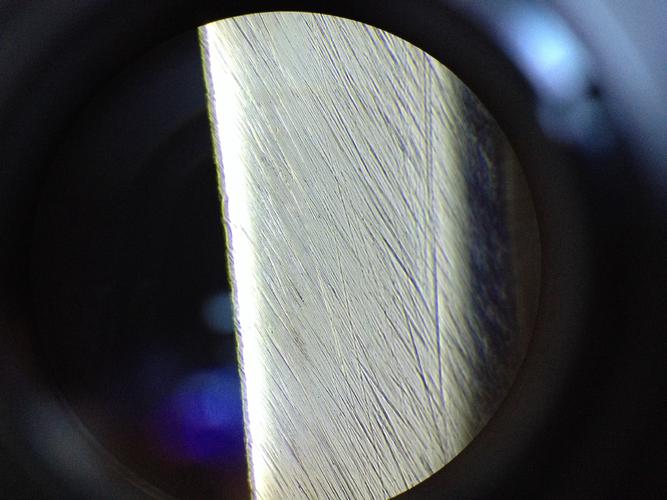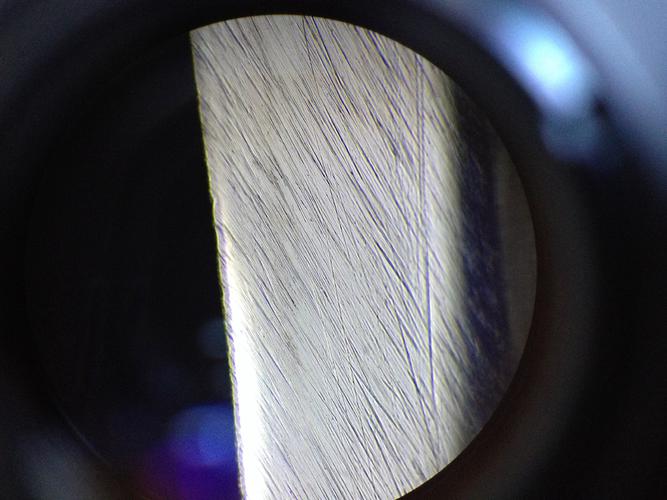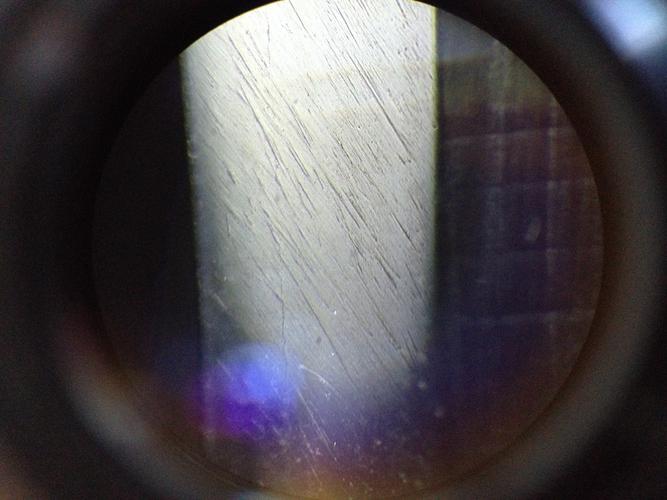Results 1 to 10 of 59
-
01-09-2015, 07:38 PM #1
 Grit issues, does any one else see a problem here
Grit issues, does any one else see a problem here
I have been looking at a knife edge for about an hour getting frustrated and scratching my head. Tell me what you see when it comes to the scratch pattern. Note please forgive the poor pics. It's hard to take a pic through a eyepiece and hold a light at the same time. These are done at 100x. The grits are 8k and 16k.
16k


8k


Again in sorry for the poor pics. Tell me if you see a problem. The pics are not switched and the 16k was freshly flattened with a DMT325 and rinsed/cleaned off the best I could.
Forgot to mention both of these are Shapton GSLast edited by rlmnshvstr8; 01-09-2015 at 07:41 PM.
A fool flaunts what wisdom he thinks he has, while a wise man will show that he is wise silently.
-
01-09-2015, 08:21 PM #2illegitimum non carborundum



- Join Date
- Jan 2008
- Location
- Rochester, MN
- Posts
- 11,552
- Blog Entries
- 1
Thanked: 3795
I assume your concern is that the 16k scratches are more dense than the 8k scratches. I guess without more photos and information, I'm not concerned.
Then again, they are not my hones or blades!
The greatest concern is the depth of the scratches and the 16k scratches SEEM deeper but it is hard to tell.
-
01-09-2015, 08:29 PM #3

Yes I am concerned by the density of the scratches. Mainly that my edge is getting less polished on the 16k. I was thinking that if this is doing this on my knife what is it doing to my razor.
A fool flaunts what wisdom he thinks he has, while a wise man will show that he is wise silently.
-
01-09-2015, 08:40 PM #4illegitimum non carborundum



- Join Date
- Jan 2008
- Location
- Rochester, MN
- Posts
- 11,552
- Blog Entries
- 1
Thanked: 3795
Well analysis of data is better than speculation. How about repeating this with a couple of razors?
How many strokes did you do on each hone?
In general you should not do many strokes on a 16k with a razor.
-
01-09-2015, 09:05 PM #5

To get a better idea of what is going on, you may also want to change your honing direction between the 8k and the 16k, so that you can better see when the 8k scratches are gone. Make a crisscross pattern and stop when you can't see the 8k scratches anymore.
You will see more scratches per inch with a 16k than with an 8k because there is more grit per inch in the 16k than the 8k.
The 16k scratches should be narrower than the 8k scratches due to a smaller grit.
The 16k scratches should be shallower than the 8k scratches as well, but it is hard to judge the depth of cut in a picture.Some people never go crazy. What truly horrible lives they must lead - Charles Bukowski
-
01-09-2015, 09:23 PM #6

Yeah it's hard to judge under the microscope too on the depth. Normally I don't look under my work microscope because the lighting is really hard to manage so I usually use a 45x lighted loupe. Under the loupe as I progress up the grits I always see a finer scratch patter with each grit level and almost a mirror reflection under the loupe at 8k until I get to the 16k. then the edge looks "scratchier" and less mirror like than the 8k. An so is my fear that my 16k is polishing less than the 8k. Because of this I decided to get the higher powered microscope out in hope to see what is going on.
A fool flaunts what wisdom he thinks he has, while a wise man will show that he is wise silently.
-
01-09-2015, 09:24 PM #7

And what's the difference between what the edges can do? I'm not one to look at pictures of scratch patterns, because that's not where the rubber meets the road. Having said that, that's probably why I can't really pull much meaningful information from pictures of scratch patterns...
-
01-09-2015, 11:05 PM #8

The pics do not seem to be of the same area ?
The white gleam of swords, not the black ink of books, clears doubts and uncertainties and bleak outlooks.
-
01-09-2015, 11:35 PM #9
 A fool flaunts what wisdom he thinks he has, while a wise man will show that he is wise silently.
A fool flaunts what wisdom he thinks he has, while a wise man will show that he is wise silently.
-
01-09-2015, 11:40 PM #10

Oh and before it's mentioned I examined the edge at 8k before moving to the 16k and the 8k was comparable to the above 8k. I just don't have any pics because I didn't think to snap a pic before I moved up to the 16k to see what it was doing.
A fool flaunts what wisdom he thinks he has, while a wise man will show that he is wise silently.


 33Likes
33Likes LinkBack URL
LinkBack URL About LinkBacks
About LinkBacks






 Reply With Quote
Reply With Quote


